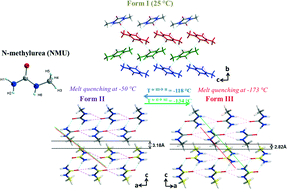Trimorphism of N-methylurea: crystal structures, phase transitions and thermodynamic stabilities†
Abstract
Melt crystallization of N-methylurea (NMU) was investigated by X-ray and differential scanning calorimetry (DSC) techniques. In addition to the known orthorhombic stable Form I, two new polymorphic forms (II and III) crystallizing in the centrosymmetric space group P21/c were obtained at different quenching temperatures. The crystal structures of Forms II and III were determined from X-ray powder diffraction data. The crystallographic results for the monoclinic forms are presented in this study, as well as a detailed comparison of crystal structures of the three polymorphs. The nature of hydrogen bonds in Form II and Form III were found to be similar; hence, a first order mechanism governed by means of shear movements is suggested where a transition via nucleation and growth could occur at low temperatures. The relative thermodynamic stabilities of the three forms of NMU were investigated by DSC analyses. Form II and Form III exhibited a reversible solid–solid phase transition at circa −118 °C. Both forms were found to be monotropically related to the stable Form I.


 Please wait while we load your content...
Please wait while we load your content...